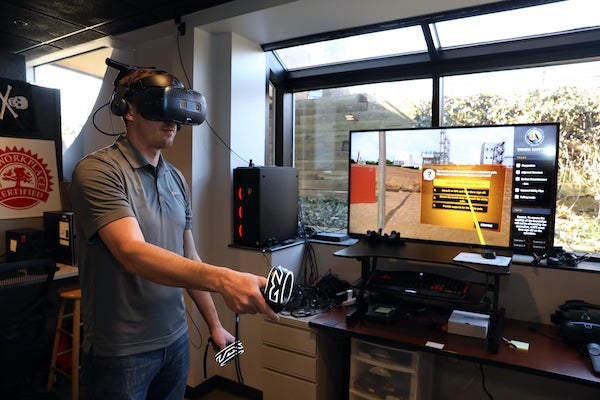News
Sign O’ the Times

Inside an unassuming air-conditioned office building in Colombia, Md., GCC member Sean Mauney straps on a pair of virtual reality (VR) glasses and is instantly transported outdoors— to a sunny construction site with mounds of dirt in the foreground and rows of Sierra-looking Mountains in the background.
He looks up to 360 degrees of blue sky above, filled with picture-perfect, slow-moving white clouds for good measure; he then looks down and focuses on the task at hand: a simulated pipeline littered with true-to-life, on-the-job hazards.
“Virtual reality is no longer the thing of novelty or gaming, it is now mainstream and being put to practical use,” he explained from behind the futuristic eyewear, noting that the technology on his head is currently being used by union apprenticeship programs throughout the country.
“Workers are better prepared when they can immerse themselves in a replica of the jobsite before ever visiting it,” Mauney said.
New Learning Methods
As a multimedia developer for Mosaic Learning, what Mauney creates isn’t always visible to the naked eye. He and his co-workers on the interactive content team are responsible for developing the cutting-edge training applications.
Mauney switches glasses to demonstrate a less altered but equally innovative (and impressive) technology known as augmented reality (AR). Unlike VR, AR enhances the real world but doesn’t replace it.
The AR experience is altered but rooted in reality, he explains, providing another demonstration of a program currently in use for medical workers in the health care industry. This time, the room stays the same, save for the holographic projection of a human leg that looks to be sitting on the (actual) table in front of him.
“Medical students are able to learn like never before with AR,” he said, gripping a controller and pointing to a red dot onto the simulated leg. He then clicks on the spot, just slightly below the kneecap, and a virtual screen pops onto the wall behind the table—filled with facts and additional options to absorb more information.
The fully realized workplace environments of AR and VR are as real as it gets in the digital world, transforming the user experience through real-world simulations—and, consequently, transforming the old models of learning.
Game Changers
For over a decade, Mosaic Learning has been leading the way in advancing union apprenticeships throughout the country thanks to their cutting-edge technology. Unlike most tech companies, the GCC-represented Mosaic has pioneered the emerging technology to benefit workers.
“When it comes to job training, these new technologies are truly a game changer,” said Tomi Okigi, a software developer for Mosaic Learning.
Although the labor movement and virtual reality may seem like an odd pairing, Okigi believes that the two make for a perfect match at Mosaic Learning—and that the Teamsters make for a fitting union representative.
“Team cooperation is part of everything we do, and comradery is essential to our team,” he said, explaining how the tech world works in groups known as a “scrum team.”
“Scrum encourages teams to learn through experiences while working on a problem, to better organize our efforts and reflect on their wins and losses to continuously improve,” Okigi said.
Elevating workers
Like Mauney, the mission of Mosaic holds a meaningful significance to Okigi and his fellow software developers.
“On top of being interesting work, it’s also rewarding to know you are helping people and the labor movement. We are helping union members as union members,” he said. “Ultimately, it’s about providing a training tool to elevate workers.”
Changing times call for new approaches. At Mosiac Learning, technology has purpose and the strange new world of tomorrow is a lot more practical.
For more information, visit mosaiclearning.com.